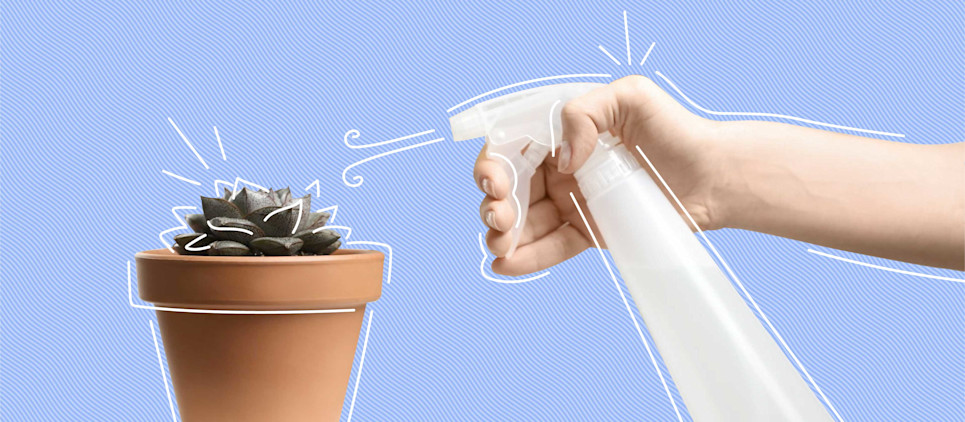Succulents give your space character and style—here’s how to help them flourish
As indoor plants go, succulents have a reputation for being low-maintenance and chic. They come in a vast array of eye-popping colors, sizes, and fascinating textures, making them an ideal companion for a work desk, a kitchen table centerpiece, or a bedside or bookshelf accent. Here’s how to keep them healthy and happy in your home.

Table of contents
2 Principles of succulent care5 Care tips for keeping indoor succulents happy and healthy1. Use the right soil2. Find the right pot3. Find the right light4. Use the right amount of water, at the right time5. Manage pests2 Principles of succulent care
Growing succulents indoors is mostly about restraint. They might be the closest thing to set-it-and-forget-it you’ll find in the plant world, but there are two main points to remember:
Sunshine is life. Succulents will always be happiest with loads of bright, warm light.
Too much water is death. Watering your succulent too much is the quickest way to knock out its fine root tendrils. Water your succulents only when soil is completely dry.
5 Care tips for keeping indoor succulents happy and healthy

1. Use the right soil
The first mistake many first-time succulent owners make is in the soil. Succulents come pre-potted in a succulent soil, a gritty mixture of sand, potting soil, and small pieces of a porous stone like pumice. This soil mix ensures proper drainage as water trickles through the delicate root systems of the plant. If you transplant to a larger pot, be sure to mimic this balance as best you can.

2. Find the right pot
The quickest way to kill your succulent is to let it sit in waterlogged soil, which is why the right pot is especially important. Good drainage holes are crucial to any succulent planter, so double check the bottom before you buy—or keep the succulent planted in a separate vessel that can be easily removed from the pot during watering.

3. Find the right light
Even though all cacti are succulents, not all succulents require the harsh desert-like conditions that cacti bring to mind. Yes, succulents thrive with sun exposure, and typically need about 6 hours of direct light a day, but do a bit of research on what kind of succulent you have before walloping it with heat. (Aloe, ironically, can get sunburned in too much sun.) Sometimes younger succulents are more sensitive to scorching.
If your succulents are facing windows, you may notice them leaning into the glass, towards the sun. Rotating the pot regularly will ensure even exposure and help the plant grow straight.
You’ll know your succulents aren’t getting as much light as they’d like when they start to stretch. This is easily remedied: Simply trim the topmost part of the succulent, leaving a small amount of stem attached. Let both the cutting and the base completely dry out. After a few days, the root end of the cutting will look a bit like a scab; this means you can plant it in fresh soil and begin again.
If you live in an area that doesn’t get much light during the day, you can also invest in a grow light with a timer to boost the health of your succulents.

4. Use the right amount of water, at the right time
It’s easy to overwater succulents. You’re just trying to be a responsible plant-owner! But the best rule of thumb here is to allow the soil to dry out completely before watering: The first inch of soil or so should be dry to the touch. When that happens, water at the root level until it runs out of the drainage holes, and then stop. Another technique is to set the pot directly in a shallow dish of water, and allow the roots to suck it up through the drainage holes. Once it’s reached the top, remove.
Spring and summer are peak growth times for succulents, which means they can handle more water. They don’t need as much nourishment during the colder months, when they enter a resting period.
One last thing—don’t mist. The impulse to mist is a good one (soil is less likely to become waterlogged with a very gentle application of water), but soaking the leaves can lead to mold and brittle roots.

5. Manage pests
Indoor succulents are less of a target for the usual garden pests than outdoor ones, but keep an eye out for gnats and mealybugs. These two are attracted to overly moist soils, and they’ll be a sign that you’ll need to either scale back or re-pot completely. You can get rid of them by spraying down the soil with a light misting of 70% isopropyl alcohol.
Bungalow offers private rooms in coliving spaces that actually feel like home, as well as the best roommates to share them with. Unlike other coliving and shared housing options, Bungalow vets all residents and helps you match with roommates who share your living preferences and interests. Find your next home on Bungalow.
Ready to find your next home?
Move-in ready homes and a built-in community so you can feel at home, together — wherever you are.
Suggested articles



